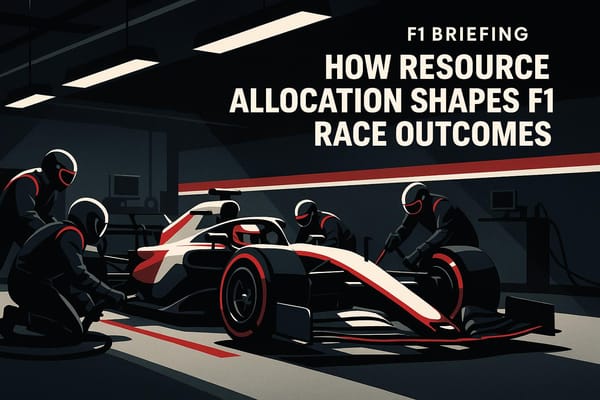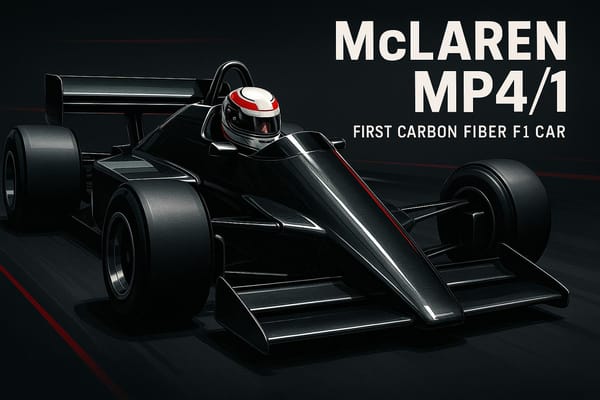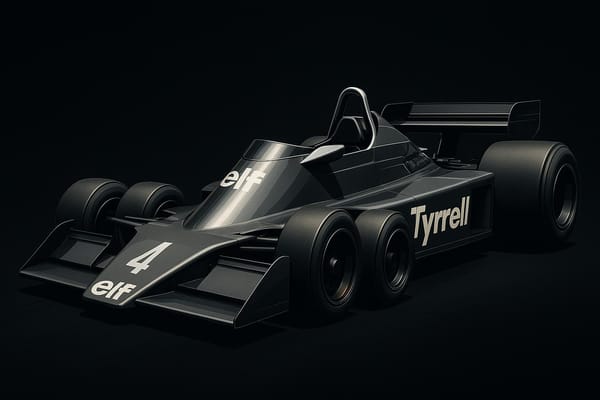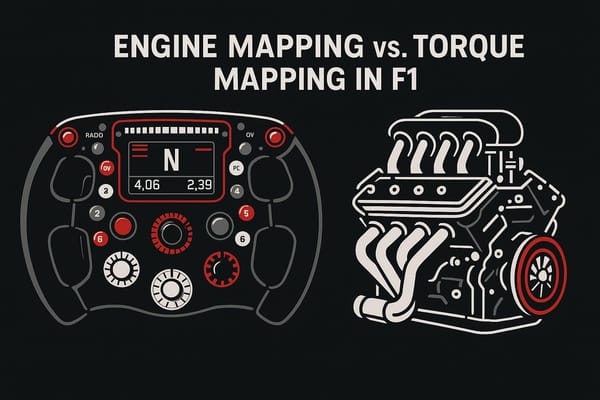7 Corner Types in F1 Tracks
Explore the seven corner types in Formula One racing and learn how they influence car performance, strategy, and tire management.
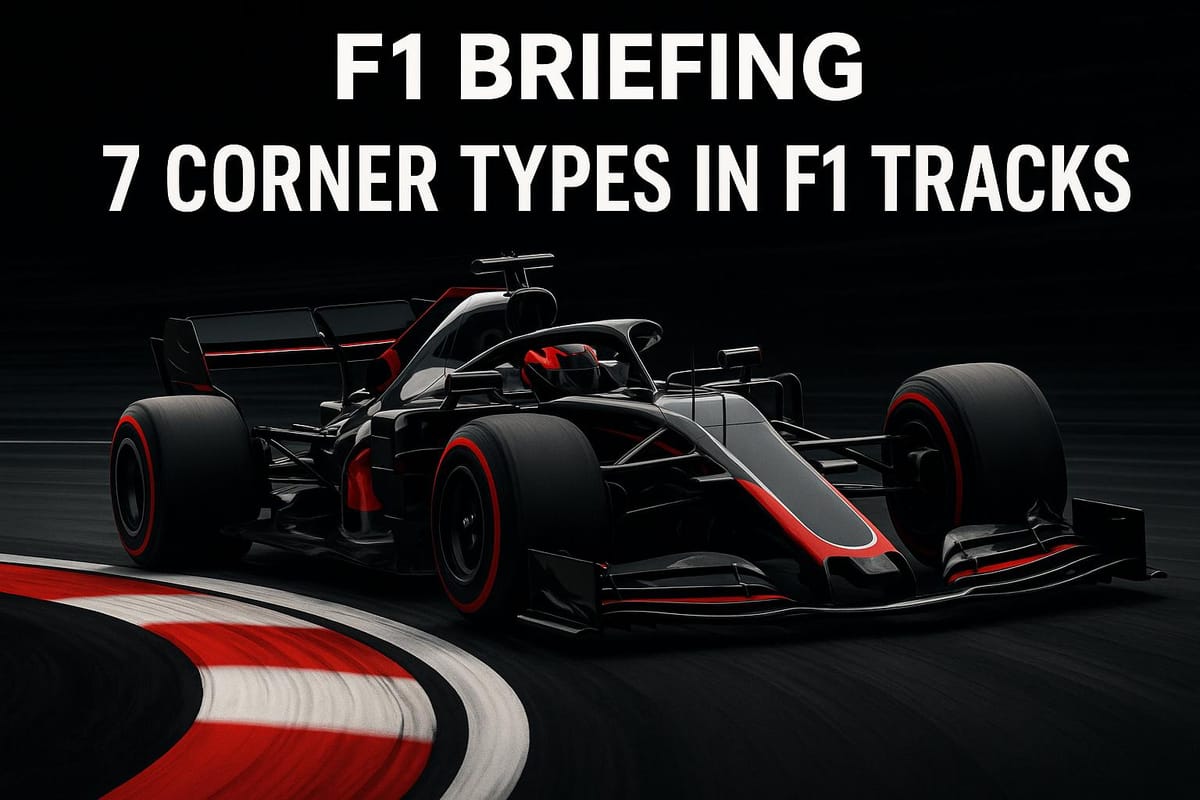
Formula One tracks include seven key corner types that challenge both drivers and engineers. Understanding these corners is crucial for race strategy, car setups, and tire management. Here’s a quick guide:
- Hairpin Corners: Sharp 180° turns requiring heavy braking and precise steering. Key for overtaking.
- Chicanes: Tight, alternating turns demanding quick directional changes and stability.
- Double Apex Corners: Two apexes in one turn, testing smooth line management and traction.
- S-Curves: Rapid directional shifts requiring balance and rhythm through multiple turns.
- Standard Radius Corners: Consistent curvature, focusing on steady steering and aerodynamics.
- Tightening Corners: Decreasing radius turns needing progressive braking and late apexing.
- Opening Corners: Increasing radius turns prioritizing strong exits for straight-line speed.
Quick Comparison Table
| Corner Type | Speed | Key Challenge | Tire Impact | Overtaking Potential |
|---|---|---|---|---|
| Hairpin | Low | Heavy braking and precise control | Increased rear wear | High |
| Chicane | Low-Moderate | Quick directional changes | Elevated wear | Moderate |
| Double Apex | Moderate | Smooth transitions between apexes | Higher lateral stress | Limited |
| S-Curves | Moderate-High | Balanced weight transfer | Sustained lateral wear | Challenging |
| Standard Radius | High | Steady steering and aerodynamics | High sustained stress | Variable |
| Tightening | Low-Moderate | Progressive braking and late apex | Front tire wear | Moderate |
| Opening | Moderate | Strong exit for straight-line speed | Rear tire load | Limited |
Each corner type impacts car setup, strategy, and performance differently. Mastering these is key to success in Formula One racing.
Formula 1 Corners (terminology) - Explained
1. Hairpin Corners
Hairpin corners are among the toughest challenges in F1 racing. These sharp, 180-degree turns force drivers to slow down significantly from high speeds, requiring flawless braking and steering control.
Technical Demands
Navigating hairpins requires powerful braking systems and a car setup that ensures stability. This includes fine-tuned brake balance and suspension adjustments to handle the extreme demands of these corners.
Impact on Car Performance
Hairpins take a toll on the car. Brakes heat up quickly due to intense deceleration, and front tires face heavy strain during braking, while rear tires work hard during acceleration out of the corner. Smooth throttle application is key to avoiding wheel spin and maintaining speed upon exit.
Driver Strategy Considerations
Hairpins often turn into prime spots for overtaking. Drivers must carefully balance aggressive moves to pass others with maintaining a defensive line to protect their position. These factors make hairpins critical for both car setup and race strategy.
Examples from F1 Tracks
| Track | Corner | Characteristics |
|---|---|---|
| Circuit de Monaco | Fairmont Hairpin (Turn 6) | A slow, tight corner that demands precise control |
| Yas Marina Circuit | Turn 14 | Features heavy braking, crucial for lap times |
| Circuit de Barcelona-Catalunya | La Caixa (Turn 10) | A key overtaking zone that tests traction on exit |
Errors in hairpins can lead to lost time and missed opportunities, making them a pivotal aspect of any race.
2. Chicanes
Chicanes are a series of tight, alternating turns designed to slow cars down and test precision. While they share similarities with hairpins, chicanes challenge teams with rapid directional changes, requiring a careful balance between mechanical grip and aerodynamics.
Technical Demands
Navigating chicanes successfully depends on both car setup and driver skill. The suspension must handle quick weight shifts from side to side, while precise steering and strong grip are essential to maintain stability during these transitions.
Impact on Car Performance
The repeated lateral load shifts in chicanes put significant strain on the suspension, tires, and braking systems. Maintaining downforce is crucial to ensure stability through these quick changes. As with other corner types, teams must fine-tune their setups to maximize performance in these sections.
Driver Strategy Considerations
Drivers need to maintain precise speed and positioning through chicanes. Even a small mistake at the entry can throw off the entire sequence, making it especially tricky when defending or attempting an overtake. Mastery of chicanes is a key part of handling the diverse challenges posed by F1 circuits.
3. Double Apex Corners
Double apex corners stand out as some of the toughest challenges on F1 circuits, featuring two back-to-back apexes. Navigating these corners requires specialized engineering tweaks and precise driving techniques.
Technical Demands
Double apex corners call for highly specific adjustments to a car’s aerodynamics and suspension. Unlike single apex turns, their two-stage nature demands even more refined tuning. For example, teams may soften the front suspension to ensure better tire contact at the first apex while fine-tuning rear settings to maximize traction during exit. At Bahrain’s Turns 9/10, engineers often increase rear wing angles to reduce wheelspin between the apexes. Meanwhile, the suspension must handle sustained lateral forces of up to 5G, pushing both the car and driver to their limits.
Impact on Car Performance
These corners put a heavy strain on tires and car stability. Take Suzuka’s Spoon Curve as an example: drivers face intense lateral forces for nearly four seconds, causing tire temperatures to rise by about 30°F. To maintain balance, engineers typically set the rear differential locking to 85–90%, allowing for smoother rotation through the first apex while ensuring traction on exit.
Driver Strategy Considerations
Drivers often rely on a 'split apex' strategy to maximize speed and positioning through these sequences. For instance, at Circuit de Barcelona-Catalunya's Turns 3/4, the combined 270° right-hander offers key overtaking chances but requires flawless throttle control. This level of precision reflects the broader demands across an F1 track.
"At Shanghai's Turns 1/2, 78% of overtakes occur by carrying 4-6 mph (6-10 km/h) extra speed through the first apex to gain inside position for the second." – F1 Briefing 2024 analysis
Examples from F1 Tracks
Here are some of the most demanding double apex corners in Formula One:
- Suzuka's Spoon Curve: A technical challenge where cars hit speeds of 155 mph through the first apex.
- Bahrain's Turns 9/10: A tight 180° double-left turn requiring precise throttle control.
- Barcelona's Turns 3/4: A sweeping, combined 270° right-hander that plays a role in DRS activation timing.
These examples underline the collaboration between drivers and engineers in fine-tuning performance for such complex turns.
4. S-Curves
S-curves are among the most challenging parts of Formula One tracks, requiring quick shifts in direction that test both car dynamics and driver expertise. Similar to hairpins and chicanes, these sections demand a perfect mix of mechanical tuning and driver precision, with adjustments tailored to the unique demands of each corner.
Technical Demands
Navigating S-curves requires fine-tuned engineering. For better control, teams often reduce front anti-roll stiffness by 6–8%. Differential settings are adjusted with a 50–60% preload on torque vectoring systems to minimize wheelspin during rapid direction changes. Energy recovery is also optimized, with MGU-K systems increasing harvesting by 20–30%, translating to an additional 0.3–0.4 MJ per lap. For instance, Mercedes' 2024 power unit maintains about 98% energy deployment consistency in these sequences.
Impact on Car Performance
The rapid weight shifts in S-curves demand significant downforce, typically between 7,700 and 8,800 pounds. Suspension systems are calibrated to handle continuous lateral forces while ensuring consistent tire contact with the track.
| Performance Factor | Impact on S-Curves |
|---|---|
| Optimal Front Wing Angle | 3.5–4° |
| Brake Bias Setting | 55–60% |
| Lateral G-Forces | Up to 4G |
| Power Unit Response Time | 50ms |
Driver Strategy Considerations
Drivers must maintain a steady rhythm through S-curves, timing their inputs carefully to manage lateral forces exceeding 4G. These sections typically push cars to use about 85% of their maximum lateral grip, requiring precise throttle and steering control. At Suzuka, for example, S-curves make up 15–18% of the total lap time in modern F1 cars.
Examples from F1 Tracks
Suzuka's S Curves (Turns 3–7): In 2019, Lewis Hamilton hit speeds of 177 mph here with the Mercedes W10. Most drivers navigate this section at speeds ranging from 93 to 106 mph, managing multiple rapid directional changes.
Circuit de Barcelona-Catalunya: The final sector (Turns 13–15) highlights the importance of aerodynamics. In 2022, Red Bull's RB18 shaved about 0.4 seconds per lap in this section thanks to an advanced floor design.
"At Shanghai's Turns 1/2, 78% of overtakes occur by carrying 4–6 mph (6–10 km/h) extra speed through the first apex to gain inside position for the second." – F1 Briefing 2024 analysis
5. Standard Radius Corners
Standard radius corners require steady steering and well-balanced car setups, making them a test of both handling and aerodynamics. Teams must tweak their setups to meet the unique demands of these turns.
Technical Demands
These turns challenge teams to strike the right balance between downforce and mechanical grip to handle the constant lateral forces. The steady steering input demands a suspension system that responds smoothly and delivers predictable handling throughout the curve.
Impact on Car Performance
The continuous curve puts long-lasting pressure on tires and the chassis. Smooth and controlled power delivery is key to maintaining traction, avoiding understeer, and keeping tire wear in check.
Driver Strategy Considerations
Drivers need to maintain momentum with precise turn-in and a smooth approach to the apex. How well they handle these corners can have a direct effect on their lap times and overall race performance.
Examples from F1 Tracks
Albert Park's Turn 3 challenges drivers with medium-speed consistency, while Silverstone's Copse Corner demands high-speed precision. These examples highlight how standard radius corners test both engineering accuracy and driving skill at various speeds.
6. Tightening Corners
Tightening corners, or decreasing radius turns, are some of the most challenging sections on a track. These turns gradually become sharper toward the exit, requiring a combination of precise driving and a well-tuned car setup. Similar to hairpins and chicanes, these corners highlight the variety of challenges drivers and engineers face on the track.
Technical Challenges
Navigating tightening corners demands specific adjustments to handle the increasing lateral forces as the turn sharpens. Teams typically focus on:
- Brake balance: Adjusted to manage shifting weight effectively.
- Steering systems: Fine-tuned for consistent precision through the changing radius.
- Suspension settings: Calibrated to handle the added stress as the corner tightens.
These technical tweaks play a key role in maintaining performance through the corner and into the next section of the track.
Effects on Car Performance
Tightening corners put a strain on various car components, making them a critical test of durability and precision:
- Tire wear: Accelerates due to the increasing lateral forces.
- Brake wear: Intensifies from the heavy braking and modulation required.
- Throttle control: Must be precise to ensure a smooth and effective exit.
Each of these factors can significantly influence a car's performance over the course of a race.
Driver Tactics
Drivers must adapt their strategies to handle the unique demands of tightening corners. Key adjustments include:
- Wide entry: Approaching the turn from a wider angle to maximize control.
- Late apex: Targeting a later apex to optimize the exit trajectory.
- Progressive braking: Gradually reducing speed to match the corner's decreasing radius.
These corners often become pivotal moments during a race, exposing differences in car setups and driver skill that can ultimately impact the outcome.
7. Opening Corners
Opening corners are turns where the radius gradually increases, allowing drivers to pick up speed as they exit. These corners are all about setting up for a strong exit, which is key to gaining momentum for the next straight. To handle them effectively, both car setup and driving technique need to be adjusted.
Technical Challenges
As the radius of the corner widens, maintaining the car's balance and traction becomes critical. Drivers need to be precise with throttle and brake inputs to ensure a smooth transition through the turn and maximize their speed on the way out.
How It Affects Performance
Nailing an opening corner can significantly improve lap times. By carrying more speed onto the straight, drivers gain a crucial advantage.
Driver Approach
In these corners, drivers often trade entry speed for a clean, high-speed exit. This strategy ensures they can accelerate effectively onto the straight.
Real-World Example
Take the final corner at Circuit de Barcelona-Catalunya. This opening corner feeds directly into the main straight, making a strong exit essential for quick lap times and setting up overtaking opportunities.
Car Setup and Race Planning
Understanding different types of corners is key to fine-tuning car setups and shaping race strategies. Teams tweak suspension and aerodynamics to match the demands of each circuit for top performance.
Suspension and Aerodynamics
Teams adjust suspension settings to balance grip and stability based on the track's corner profile. For circuits with tight, low-speed corners, setups that boost traction are prioritized. On tracks with faster sections, stability and smooth exit speeds take precedence. Aerodynamic adjustments go hand-in-hand with these changes, ensuring the car performs well in braking and acceleration zones. These technical tweaks lay the groundwork for broader strategic decisions.
Strategic Overtaking Zones
Hairpins and chicanes often serve as ideal overtaking spots due to the heavy braking they require. Teams prepare by planning energy deployment and fine-tuning braking systems to gain an edge in these areas.
Tire Management
Corner types play a major role in tire wear. Teams use this knowledge to craft strategies that keep them competitive throughout the race.
Fuel Consumption Planning
Corners also impact fuel usage. Quick acceleration zones tend to burn more fuel, while slower, technical sections allow for better fuel efficiency.
Race Day Adaptations
Conditions can change on race day, requiring real-time adjustments. For instance, a setup optimized for tight corners might need tweaking for faster sections, emphasizing the importance of staying flexible. These considerations highlight how corner characteristics directly influence performance in Formula 1.
Corner Types Quick Guide
Here's a breakdown of the seven corner types in F1, highlighting their characteristics and how they influence races:
| Corner Type | Typical Speed | Technical Requirements | Tire Impact | Overtaking Potential |
|---|---|---|---|---|
| Hairpin | Low speed | Heavy braking and precise steering inputs | Increased rear tire wear from intense braking | High – prime spot during braking zones |
| Chicane | Low to moderate speed | Quick directional changes and agile handling | Elevated tire wear due to frequent braking | Moderate – good chance in braking phases |
| Double Apex | Moderate speed | Smooth line management and consistent acceleration | Higher lateral tire stress | Limited – requires optimal exit speed |
| S-Curves | Moderate to high speed | Balanced weight transfer and stable handling | Sustained lateral forces accelerate wear | Challenging – few overtaking opportunities |
| Standard Radius | High speed | Steady steering and stable aerodynamics | High sustained speeds stress tire compounds | Variable – depends on setup and timing |
| Tightening | Low to moderate speed | Progressive braking and precise apex timing | Notable front tire wear from braking loads | Moderate – late braking can create chances |
| Opening | Moderate speed | Early apex with strong acceleration on exit | Higher rear tire load on exit | Limited – favors defensive setups |
This table condenses the key elements that influence car setups and driver strategies.
Corner performance depends heavily on track conditions. High-speed corners, for instance, generate strong lateral forces that accelerate tire wear, making tire management a critical aspect of race strategy.
For drivers, success comes down to adjusting entry speeds, hitting apexes with precision, optimizing exits, and balancing tire conservation. This guide offers a quick snapshot of how each corner type impacts car handling and race tactics.
Conclusion
Understanding the seven corner types plays a key role in improving race performance. Each type presents unique challenges for car setup, tire management, and overtaking strategies.
Different corner types heavily influence race planning. For instance, tracks with several hairpins demand efficient brake cooling and precise throttle control. On the other hand, circuits with high-speed corners prioritize aerodynamic tuning for better performance.
Key factors for success include:
- Driving Adjustments: Tailoring techniques to handle specific corner types
- Strategic Tire Management: Addressing wear and tear based on corner demands
- Balancing Speed and Control: Achieving the right setup for optimal performance
Teams fine-tune their cars to match the track's corner characteristics by focusing on:
- Aerodynamics
- Suspension settings
- Brake balance
- Component modifications
Each corner type introduces specific technical challenges, shaping the broader race strategy. For a deeper dive into Formula One track dynamics, race strategies, and technical details, check out F1 Briefing. Their expert insights break down how corner designs impact race outcomes.
FAQs
How do the different types of corners on F1 tracks influence tire wear and race strategies?
The seven main corner types on F1 tracks - such as hairpins, chicanes, and high-speed sweepers - play a critical role in tire management and race strategy. Each corner type places unique demands on the tires, affecting grip, wear, and temperature. For example, tight hairpins cause heavy braking and acceleration, which can lead to increased tire wear, while fast sweepers generate high lateral forces, heating the tires and potentially accelerating degradation.
Drivers and teams tailor their strategies based on these corner characteristics. They may adjust tire pressures, manage pace, or plan pit stops to optimize performance and longevity. Understanding how a track's layout impacts tire behavior is key to gaining a competitive edge during a race.
What challenges do engineers face when tuning F1 cars for different corner types?
Engineers face a variety of challenges when setting up Formula One cars for specific corner types, as each corner demands a unique balance between speed, grip, and stability. For high-speed corners, cars require reduced aerodynamic drag and strong downforce to maintain speed without compromising control. In contrast, tight, low-speed corners demand precise mechanical grip and responsive handling to navigate the turn efficiently.
Another key challenge is balancing the car's setup for a track with a mix of corner types. Engineers must find a compromise that allows the car to perform well across the entire circuit, often prioritizing sections where the most time can be gained. Factors like tire wear, suspension stiffness, and brake performance also play a critical role in optimizing the car for different cornering demands, making this a highly complex task.
Why are hairpin corners ideal for overtaking in Formula One races?
Hairpin corners are excellent overtaking opportunities in Formula One because they require drivers to brake heavily and significantly reduce their speed. This creates a chance for trailing cars to close the gap and attempt a move on the inside or outside of the turn.
Additionally, the tight nature of hairpins often forces cars to take different racing lines, which can lead to side-by-side battles and strategic positioning. Drivers with better exit speed out of the corner can also gain an advantage on the following straight, making hairpins critical for both defensive and offensive strategies.

